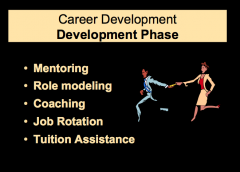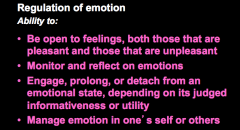![]()
![]()
![]()
Use LEFT and RIGHT arrow keys to navigate between flashcards;
Use UP and DOWN arrow keys to flip the card;
H to show hint;
A reads text to speech;
19 Cards in this Set
- Front
- Back
|
What is the definition of career development?
|
An ongoing, formalized effort that focuses on developing enriched and more capable workers.
� |
|
|
How can organizational and individual career needs be linked to create a successful career development program? (From the organization's perspective)
|

|
|
|
How can organizational and individual career needs be linked to create a successful career development program? (From the employee's perspective)
|

|
|
|
Describe the career development process
|

|
|
|
What is part of the (self) assessment phase of the career development process?
|

|
|
|
What is part of the (organizational) assessment phase of the career development process?
|

|
|
|
What is part of the direction phase of the career development process?
|
COMPETENCIES: The direction phase of career development involves determining the type of career that employees want and the steps they must take to realize their career goals. Unless the direction phase is based on a thorough assessment of the current situation, the goals and steps identified may be inappropriate.
It can be achieved through information services and career path determination. |
|
|
How can information services be used in the direction phase of the career development process?
|

Job-posting systems: easy way to provide employees with information on job-openings
Skills inventories: can be used to get overall picture of workforce training and development needs, as well as to identify existing talent in one department that may be more productively employed in another. They are useful to EEs also in that they can compare how they stack up against others in the company, encouraging them to improve their skills Career Paths: presents the possible steps in a career and the associated timetable. They should specify qualifications necessary. Can be generated by a computer via survey responses to how long certain steps take, requirements necessary, etc. Career Resource Center: collection of career development material |
|
|
What is career path?
|
Possible directions and career opportunities,
steps and timetable. |
|
|
What is part of the development phase of the career development process?
|

|
|
|
What are the steps that can be taken to help make career development an organizational priority?
|

|
|
|
What are some coaching tips?
|

|
|
|
What are the suggestions for self-development?
|

|
|
|
What are the suggestions for advancement?
|

|
|
|
1. What is emotional intelligence?
2. Why is it important to HR? 3. What are the universal primary emotions? |

1. emotional intelligence is the handling of relationships and interactions with others
2. Important to HR because research findings are increasingly showing that people high in emotional intelligence are more successful in certain ways on the job |
|
|
How does an emotionally intelligent person appraise, perceive, and express emotion?
|

|
|
|
How does an emotionally intelligent person use emotions to facilitate thinking?
|

|
|
|
How does an emotionally intelligent person understand and analyze emotional information?
|

|
|
|
How does an emotionally intelligent person regulate emotion?
|

|

